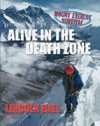Alive in the death zone by Lincoln Hall

Random House Australia, 2008.
ISBN 9781741663372
(Ages 11+) Highly recommended. Alive in the Death Zone by
Australian
mountaineer Lincoln Hall successfully aims at the children's market,
and is an adaptation of his adult book Dead Lucky.
The title refers to the author's miraculous survival from being left
for dead overnight at 8,500 metres, just after summiting Mt
Everest. Only the last 3 of 12 chapters are on this
subject. Earlier chapters describe how Lincoln was introduced to
climbing through his school's PE teacher and follows his career from
initial excursions into the Brindabella's (ACT) and Blue Mountains,
through to training in New Zealand and then completing his first
Himalayan climb of 7,000 metre Dunagiri. It also
describes how he worked as a trek leader and expedition photographer
before his 2006 Mt Everest climb.
This book is brilliantly put together with the autobiographical story
being regularly broken up with informative text boxes and captions on
such topics as acclimatisation, snow blindness, dangers of couloirs
(mountain gullies), yaks, lists of equipment etc. The 103 pages
include 90 stunning photos enticing even the laziest person to have a
browse. Reality is enhanced with a photo of Lincoln's black and
decaying frostbitten fingers, parts of which are later amputated.
This book can be read in less than 2 hours, or savoured a chapter at a
time.
The climbing history of Everest is summarised: from the 1924 Mallory
expedition; the problem that access from either Tibet or Nepal was
forbidden for many years; and the successful attempt by Edmund Hillary
and Sherpa Tenzing Norgay in 1953. A list of the
world's highest mountains, a glossary and even a snakes and ladder type
game of 'the Everest summit' also contribute to make this book
educational.
Alive in the Death Zone is highly recommended for all upper
primary and
secondary libraries. Its picturesque cover and colourful and varied
presentation from page to page will hold the interest of all.
Additionally it will be a useful reference for those doing climbing in
outdoor education. Adults seeking an inspiring story also will
love this book and find themselves subconsciously extending their
knowledge.
Kay Haarsma (Salisbury East High School)